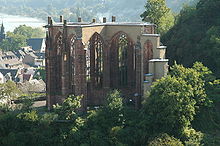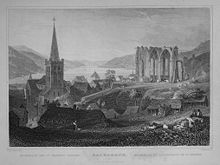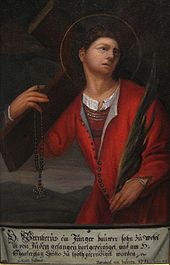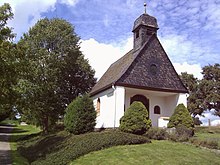Werner von Oberwesel
Werner von Oberwesel (also Werner von Bacharach or Werner von Womrath ; * 1271 in Womrath , Hunsrück ; † 1287 ) was a day laborer whose unexplained death was blamed on Jews and thus led to bloody persecution of Jews on the Middle Rhine . He was long venerated as a popular Catholic saint ; his feast day was April 19th. A "Werner" chapel in Bacharach am Rhein was expanded for him from 1289 in anticipation of pilgrims and, typical of the time, the financial fruits of a pilgrimage. His veneration - which was financially rewarding at times - led to inflammatory legends about alleged host sacrilege , ritual murder and miracles . Jewish pogroms and anti-Judaist propaganda remain associated with his name . In 1963 Werner's name was deleted from the list of saints.
history
Werner came from a poor background and was employed by a Jewish family. On Maundy Thursday 1287, the 16-year-old's body was found near Bacharach . Rumors of ritual murder spread by interested parties found acceptance among people who were controlled by Christian anti-Judaist prejudices typical of the time. According to the legend of the ritual murder , he is said to have been jointly murdered by Jews who ritually used his blood for the Jewish Passover festival.
A wave of pogroms followed the alleged communal Jewish murder . It not only shook places in the Middle Rhine, but also spread along the Moselle and in the Lower Rhine area. The Jewish communities turned to King Rudolf I , who was convinced of the baselessness of the accusations. He imposed a fine on the murderers of the Jews and ordered that Werner's corpse be cremated to prevent further veneration.
Adoration
The royal instructions to burn Werner's body to prevent further veneration were not followed. Rather, according to a legend of saints dating from before 1338, the first "miracles" at Werner's grave should have occurred since April 30, 1287, who was then venerated as a martyr . The Kunibert chapel in Bacharach was expanded into today's Werner chapel as early as 1289 . As early as 1293, a Werner altar was consecrated in the completed southern arm and in 1337 the east choir was consecrated. The planned expansion of the chapel into a large church remained unfinished for the time being, after the building budget was lost in 1338, probably because the Archbishop of Trier, Baldwin of Luxembourg , confiscated it. The chapel was only completed after 1426 at the instigation of the theology professor and humanist Winand von Steeg , who was pastor in Bacharach from 1421 to 1438. Until the introduction of the Reformation in Bacharach, the chapel was a popular place of pilgrimage. In 1685, when the Catholic Princely House of Palatinate-Neuburg inherited the Palatinate, the chapel was assigned to the few Bacharach Catholics as a parish church, but as early as 1689 during the Palatinate War of Succession the chapel was damaged when Stahleck Castle was blown up and then fell into ruins. Reconstruction also failed due to the decline in the veneration of martyrs and thus to the dwindling income for the church from pilgrims .
The Latin legend, which originated before 1338, reports the alleged sacrilege of the host ; the Jews would have hung Werner by his feet in order to steal a host that he was about to swallow. Then they would have thrown him into the Rhine. The Werner chapel was built over the place on the banks of the Rhine in Bacharach, where the body is said to have washed ashore .
A second place of worship was found in the Mutter-Rosa-Kapelle, former Werner chapel of the Heiliggeistspital of Oberwesel , about 7 kilometers down the Rhine.
Count Palatine Ludwig III. sought a revival of the cult. The following attempts at canonization between 1426 and 1429 brought official recognition. The chapel was finally completed. After some of the relics had been transferred to Besançon in 1548, the worship of Werner also spread in France.
Although the Bacharach Chapel was destroyed in 1689 and the relics were lost, the Werner Festival in the Diocese of Trier lasted until 1963, when Werner's name was deleted from the list of saints after the Second Vatican Council .
The good wine boy Werner is revered as one of seven wine saints on the Middle Rhine .
research
Such anti-Jewish legends were widely circulated in the Middle Ages and early modern times. Allegations of alleged "ritual murders", but also of the "sacrifice of the host" or " well poisoning ", which were considered to be the cause of epidemics such as the plague, fueled hostility towards Jews among broad Christian masses.
Recent research suggests that Werner probably fell victim to a sex crime. The suspicion of a perpetrator from the immediate environment, which is still evident today, was used by anti-Jewish people, as a makeshift of the implication of the host evil, to incite Jews in general.
It was not until 1963 that the Wernerkult was deleted from the calendar of the Diocese of Trier. But the "Saint Werner von Oberwesel" still appears in German lists of saints. The chapel dedicated to him in the side of the city wall of Oberwesel facing the Rhine was renovated around 2001 and rededicated as the Mother Pink Chapel in 2008 . The chapel in Bacharach was secured as a ruin and a plaque was added with the prayer of Pope John XXIII. to change the mind of Christians in their relationship to the Jews:
“Today we recognize that centuries of blindness have covered our eyes so that we no longer saw the beauty of your chosen people and no longer recognized the features of our firstborn brother. We now discover that there is a mark of Cain on our forehead. Over the centuries, our brother Abel has lain in the blood we shed and he has wept the tears we caused because we forgot your love. Forgive us the curse we wrongly attached to the names of the Jews. Forgive us that we crucified you a second time in her flesh. Because we didn't know what we were doing. "
Werner was portrayed as a saint with the attributes of a winegrower's knife as well as a shovel and tub and was considered the patron of the winegrowers.
Others
Heinrich Heine processed the legend in his fragmentary story The Rabbi von Bacherach . The beginning of his text is reproduced in Karl Martin Hartmann's artistic installation in the Werner Chapel. The writer Lion Feuchtwanger made Heine's story about Rabbi von Bacherach the subject of his doctoral thesis, which he wrote in 1907. A new edition of the book was published in 1985 by Verlag S. Fischer in Frankfurt.
See also
literature
Non-fiction
- Paul Gerhard Aring: Werner von Oberwesel. In: Biographisch-Bibliographisches Kirchenlexikon (BBKL). Volume 13, Bautz, Herzberg 1998, ISBN 3-88309-072-7 , Sp. 837-838.
- Rheinfriede Gleisner: After the pogroms of the Jews came the legend of saints ; in: Hunsrücker Zeitung, April 18, 1987, p. 27.
- Bruno Jahn: Wernher von Oberwesel (von Bacharach): Text group about the alleged Jewish ritual murder of the boy Wernher . In: Wolfgang Achnitz (Ed.): German Literature Lexicon. The Middle Ages / Volume 3: Travel reports and historical poetry . Berlin / Boston 2012, ISBN 978-3-598-24992-1 , columns 581-584.
- Gottfried Kentenich : Werner. Diocese of the diocese of Trier . In: Allgemeine Deutsche Biographie (ADB). Volume 55, Duncker & Humblot, Leipzig 1910, p. 45 f.
- Gerd Mentgen: The ritual murder affair about “Good Werner” von Oberwesel and its consequences ; in: Yearbook for West German State History 21 (1995), pp. 159–198.
- Werner Wendling: The “good Werner” has had its day ; in: Rhein-Hunsrück-Zeitung, July 4, 2006, p. 17.
- Thomas Wetzstein: From “People's Saints” to “Prince's Saints”. The revival of the Werner cult in the 15th century ; in: Archive for Middle Rhine Church History 51 (1999), pp. 11–68.
- Daniela Wolf: ritual murder affair and cult genesis. The "good Werner von Oberwesel" ; Bacharach: Bauverein Wernerkapelle Bacharach, 2002; ISBN 3-00-009539-X .
Fiction:
- Gerd Hergen Lübben : The text found on Bacherach ; in: Die Brücke - Forum for Anti-Racist Politics and Culture, Issue 140, 2/2006 (Saarbrücken), pp. 126–128.
Web links
- Joachim Schäfer: Werner von Oberwesel . In: Ecumenical Lexicon of Saints , October 27, 2016.
- Bacharach (district Mainz-Bingen) with Niederheimbach (VG Rhein-Nahe, district Mainz-Bingen): Jewish history / synagogue . Website of the Alemannia Judaica , working group for research into the history of the Jews in southern Germany and the neighboring area. (including about the Werner legend and the consequences).
- Nina Pauer, Viola Rautenberg: Werner von Bacharach: Historical and literary sources . Seminar paper at the University of Hamburg, June 13, 2006 (pdf, 406 kB)
- Matthias Schmandt: The "good Werner" von Oberwesel - or: the high art of creating a saint . Rhenish history portal of the Rhineland Regional Association, June 18, 2014 (on the origin of the legend)
- Markus Dichmann, Matthias von Hellfeld: Persecution of Jews in the Middle Ages: Pogrom of Oberwesel . Deutschlandfunk Nova , November 17, 2017 ( mp3 audio file, 32 MB, 35:14 minutes )
Single receipts
- ↑ Other texts speak of Good Friday.
- ^ Oswald Redlich: Rudolf von Habsburg. The German Empire after the fall of the old Empire. Innsbruck 1903 (and reprints; digitized in the Internet Archive ) p. 499.
- ↑ to link regional history
- ^ Werner bei Weinlehrpfad, Oberwesel
- ↑ zum.de: The Jewish Storm of 1349. Late Middle Ages on the Upper Rhine. Keywords for the era - Jews and Germans ; on both sides is the prayer We recognize today ... Because we didn't know what we were doing. of Pope John XXIII, which he held on June 3, 1963 at the 2nd Vatican Council. Note: Possibly the text continues, some sources use "... at the end ...".
- ↑ text u. a. in Heinrich Heine: Blasphemous writings (selection); The Rabbi von Bacherach. Edited and introduced by Heinz-Joachim Fischer. Marixverlag, Wiesbaden 2010. Text also as digital version online on the website of Alemannia Judaica - Working group for research into the history of Jews in southern Germany and neighboring areas: Heinrich Heine's “The Rabbi von Bacharach.” Viewed on May 23, 2018.
- ^ Wernerkapelle, Bacharach - The window. Art moves to tolerance ; Exposé dated April 2, 2008 (pdf; 982 kB)
- ^ Lion Feuchtwanger: Heinrich Heine's Rabbi von Bacherach. With Heine's narrative fragment. A critical study. Dissertation at the University of Munich in 1907; New edition S. Fischer, Frankfurt am Main 1985, ISBN 3-596-25868-5 .
| personal data | |
|---|---|
| SURNAME | Werner von Oberwesel |
| ALTERNATIVE NAMES | Werner von Bacharach |
| BRIEF DESCRIPTION | alleged victim of a ritual Jewish murder |
| DATE OF BIRTH | 1271 |
| PLACE OF BIRTH | Womrath |
| DATE OF DEATH | 1287 |




